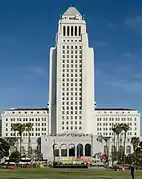La Grande Station | ||||||||||||||||
|---|---|---|---|---|---|---|---|---|---|---|---|---|---|---|---|---|
 La Grande Station c. 1911 | ||||||||||||||||
| General information | ||||||||||||||||
| Location | 2nd Street and Santa Fe Ave Los Angeles, California | |||||||||||||||
| Coordinates | 34°02′50″N 118°13′56″W / 34.0472°N 118.2322°W | |||||||||||||||
| Owned by | Atchison, Topeka and Santa Fe Railway | |||||||||||||||
| Construction | ||||||||||||||||
| Platform levels | 1 | |||||||||||||||
| History | ||||||||||||||||
| Opened | July 29, 1893 | |||||||||||||||
| Closed | May 3, 1939 | |||||||||||||||
| Former services | ||||||||||||||||
| ||||||||||||||||
La Grande Station was the Atchison, Topeka and Santa Fe Railway's (Santa Fe) main passenger terminal in Los Angeles, California from 1893 until the opening of Union Station in 1939. The station was located at 2nd Street and Santa Fe Avenue on the west bank of the Los Angeles River, just south of the First Street viaduct built in 1929.[1]
History


Santa Fe opened La Grande Station on July 29, 1893.[2][3] The station was unique for Southern California with its Moorish-inspired architecture.[4] Los Angeles Railway Yellow Cars called at the street adjacent to the station by 1920,[5] and was at different times served by the N, 7, and 9 lines.[6][7][8]
Heavy damage from the 1933 Long Beach earthquake meant the last operating years of the station were spent in a state of disrepair as portions of the building, including the dome, had to be removed for the safety of passengers. [4] When Union Station opened in 1939, Santa Fe moved all of its passenger services there.
Despite the closure, it was used as a staging ground for the Internment of Japanese Americans in Los Angeles.[4] La Grande Station was demolished in 1946.
In popular culture
Many Hollywood movies were filmed at the stylish station. Laurel and Hardy's film Berth Marks (1929) was one of the first sound movies shot on location. Other movies that used Santa Fe's La Grande Station included Choo-Choo! (1932) (Our Gang — Little Rascals), Lady Killer (1933) with James Cagney, Swing Time (1936) with Fred Astaire, and Something to Sing About (1937).
References
- ↑ Masters, Nathan (January 17, 2013). "Lost Train Depots of Los Angeles History". KCET. Retrieved May 8, 2019.
- ↑ Rasmussen, Cecilia; Times staff writer. "Union Station Helped Turn a City Into a Metropolis". Retrieved May 12, 2006.
- ↑ Brehm, Qathryn. "Los Angeles Downtown Arts District: History". Retrieved May 12, 2006.
- 1 2 3 Southern California Institute of Architecture (2004). "On the History of the Santa Fe Freight Depot, Los Angeles". Archived from the original on April 27, 2006. Retrieved May 12, 2006.
- ↑ "'N'". Electric Rail Heritage Association. Retrieved September 19, 2020.
- ↑ "7". Electric Rail Heritage Association.
- ↑ Terrass, John (1922). Study and Plan of Relief of the Street Traffic Congestion in the City of Los Angeles, California (PDF) (Thesis). University of California. p. 13. Retrieved January 29, 2021.
- ↑ H.P. Noordwal (1938). "Route Map Los Angeles Railway Electric Car and Bus Routes" (Map). Barry Lawrence Ruderman Antique Maps Inc. Los Angeles Railway. "Alternate link" (Map). via Google.
